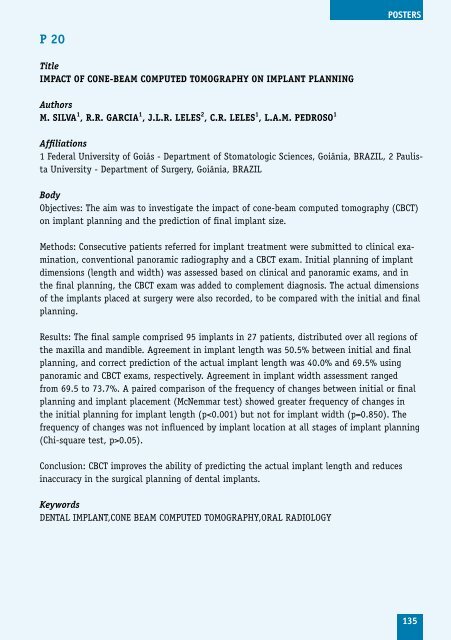Program including abstracts as pdf available here
Program including abstracts as pdf available here
Program including abstracts as pdf available here
Create successful ePaper yourself
Turn your PDF publications into a flip-book with our unique Google optimized e-Paper software.
P 20<br />
Title<br />
IMPACT OF CONE-bEAM COMPuTED TOMOGRAPHy ON IMPLANT PLANNING<br />
Authors<br />
M. SILVA 1 , R.R. GARCIA 1 , J.L.R. LELES 2 , C.R. LELES 1 , L.A.M. PEDROSO 1<br />
Affiliations<br />
1 Federal University of Goiás - Department of Stomatologic Sciences, Goiânia, BRAZIL, 2 Paulista<br />
University - Department of Surgery, Goiânia, BRAZIL<br />
Body<br />
Objectives: The aim w<strong>as</strong> to investigate the impact of cone-beam computed tomography (CBCT)<br />
on implant planning and the prediction of final implant size.<br />
Methods: Consecutive patients referred for implant treatment were submitted to clinical examination,<br />
conventional panoramic radiography and a CBCT exam. Initial planning of implant<br />
dimensions (length and width) w<strong>as</strong> <strong>as</strong>sessed b<strong>as</strong>ed on clinical and panoramic exams, and in<br />
the final planning, the CBCT exam w<strong>as</strong> added to complement diagnosis. The actual dimensions<br />
of the implants placed at surgery were also recorded, to be compared with the initial and final<br />
planning.<br />
Results: The final sample comprised 95 implants in 27 patients, distributed over all regions of<br />
the maxilla and mandible. Agreement in implant length w<strong>as</strong> 50.5% between initial and final<br />
planning, and correct prediction of the actual implant length w<strong>as</strong> 40.0% and 69.5% using<br />
panoramic and CBCT exams, respectively. Agreement in implant width <strong>as</strong>sessment ranged<br />
from 69.5 to 73.7%. A paired comparison of the frequency of changes between initial or final<br />
planning and implant placement (McNemmar test) showed greater frequency of changes in<br />
the initial planning for implant length (p0.05).<br />
Conclusion: CBCT improves the ability of predicting the actual implant length and reduces<br />
inaccuracy in the surgical planning of dental implants.<br />
Keywords<br />
DENTAL IMPLANT,CONE BEAM COMPUTED TOMOGRAPHY,ORAL RADIOLOGY<br />
POSTerS<br />
135


